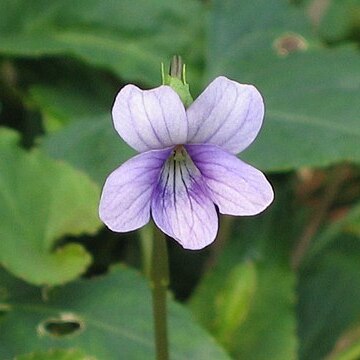Perennial; rhizome vertical or oblique, rather short and stout, with rosette of leaves and flowers at apex, acaulescent. Leaves 1¾-9 by 1-7½ cm, 1-2.2 times as long as broad, broadest at base, triangular-ovate, cordate at base with usually prominent, rounded basal lobes, acute, crenate to subdentate, sometimes dentate on basal lobes, decurrent to ⅓ length of petiole, glabrous or sparsely pubescent in sinus; petiole 1-10 cm. Stipules 3-10 by 1-2 mm, ovate-lanceolate, acute, sparsely short-fimbriate, glabrous, fuscous, adnate to petiole to ¾ of length. Flowers 9-11 mm, pale purple with darker veins; peduncle shorter than to somewhat exceeding leaves, glabrous or pubescent distally. Sepals 2½-7 by 1-1.8 mm, ovate-lanceolate, acute, glabrous or sometimes ciliate, green with scarious margin; appendage (1½-)2-4.9 mm, at least half as long as sepal, incised. Petals 2-3 times as long as broad, obovate, the laterals bearded; spur 1.8-2.6 mm, 1.1-1.3 times as long as broad, 2/5 to ½ as long as calycine appendages, cylindrical, straight, obtuse. Style c. 2 mm, geniculate at base, clavate distally, apex with large marginal lobes fused behind, anterior stigmatic beak. Capsule 9-16 mm, oblong, glabrous.
A herb without a stem. It keeps growing from year to year. It grows 6-10 cm high. The rootstock are buried deeply in the soil. Leaves and flowers emerge in the spring. The leaves come from the base from the roots. The leaves are oval or triangle shaped. They vary in shape or size. The flowers are purple. The flowers are fertilised before the flower opens. They do not have a smell. The fruit are oval capsules.

